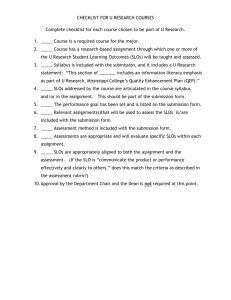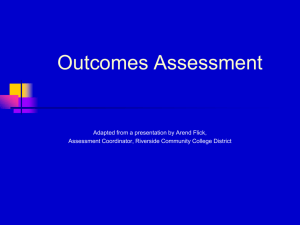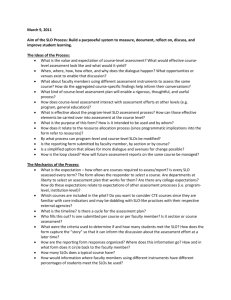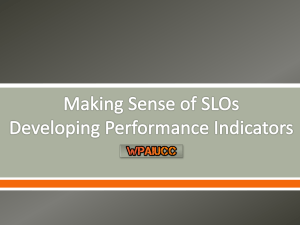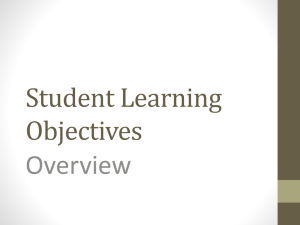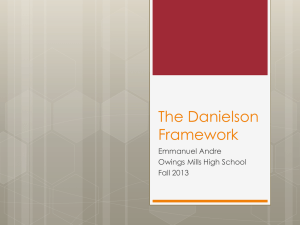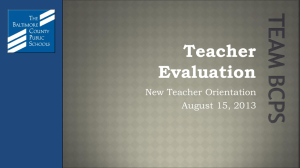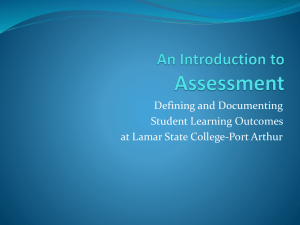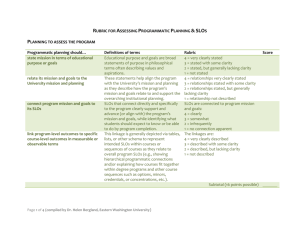Academic Student Learning Outcome Assessment Report & Plan
advertisement
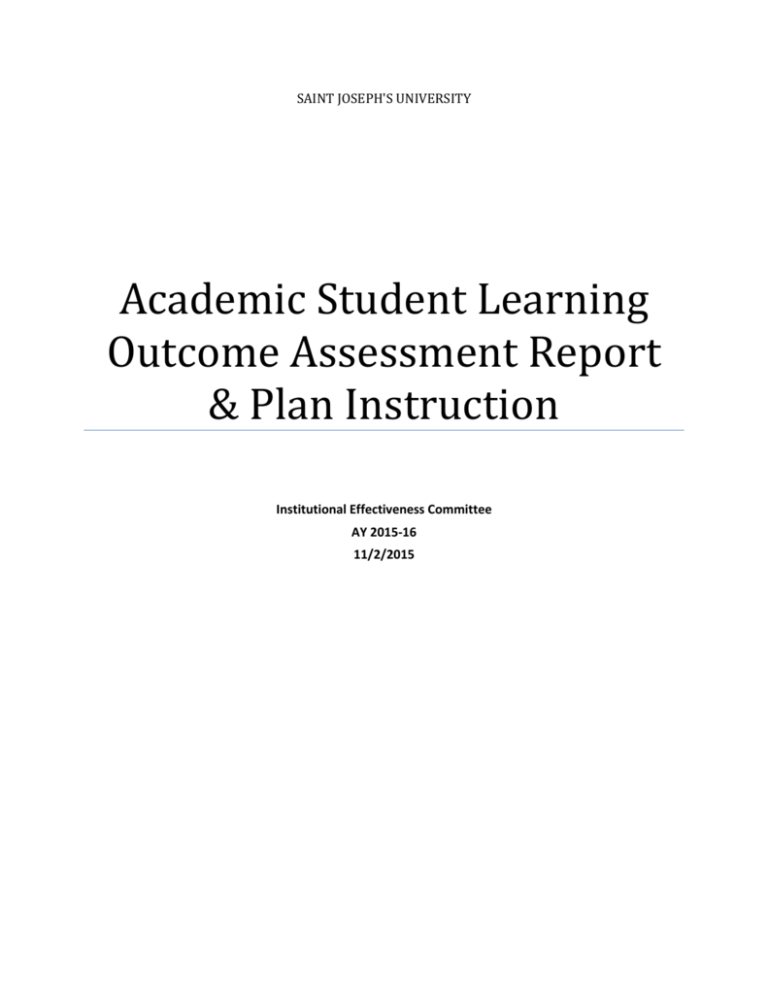
SAINT JOSEPH'S UNIVERSITY Academic Student Learning Outcome Assessment Report & Plan Instruction Institutional Effectiveness Committee AY 2015-16 11/2/2015 Academic Program Student Learning Outcome Assessment Report Instruction Reporting Overview Academic programs and student life division are required to complete their student learning outcome assessment (SLO) report and plan. These reports are due to the Dean and Institutional Effectiveness Committee (IEC) by March 31st. If a program has multiple majors/concentrations with different student learning outcomes, each major/concentration will complete their own SLO assessment report. The department chair or deans will attach all submitted SLO Assessment reports as appendices in their Department/Program Annual Report. To submit your report to IEC, please send the final report before March 31st, 2016 to Wenjun Chi, the Assistant Provost for Institutional Effectiveness and Research by emailing wchi@sju.edu. This report template is used to replace the previous templates used by individual programs in AY 2014-15. Program Student Learning Outcomes Academic programs can use the same program learning outcomes identified in their annual assessment plan submitted in the previous year. Reference: Program SLOs should be clearly articulated learning outcomes: the knowledge, skills, and competencies that students are expected to exhibit upon successful completion of academic program. (Middle States Assessing Student Learning and Institutional Effectiveness 2007) Please link all program SLOs with relevant strategic planning goals Achieving Magis (SP) and institutional level student learning outcomes. Program SLOs can be found on the AY 2015-16 Catalog. General Education SLOs (GE SLO) are temporarily used as the institutional level student learning outcomes for Academic Year 2015-16. For the definition of SP and GE SLOs please check the last page of this document. New institutional level student learning outcomes will be identified in 2016 to cover undergraduate and graduate programs in CAS, HSB and GE. Please provide all program learning outcomes of your major/program, but indicate which program SLOs were assessed in the past calendar year (spring, summer and fall) by clicking the checkbox in front of each program SLO. If your program SLO supports more than one strategic planning goals and/or general education SLOs, simply copy and paste the drop-down list to add additional goals. (Manually type in the SP and GESLO code if you are Mac users) 1 Example: ☒SLO1: Students will develop an awareness of, and an appreciation for, the professional responsibilities and ethical issues related to the field of accountancy. Supports: SP: SP1 SJU SLO: GE SLO6 Direct Measure Describe the courses and sections involved, how data was collected, sample size, the means of measurement (test, essay test question, writing samples, term paper, oral presentation, case analysis, class projects, class presentation etc.), performance expectation and timeline. Attach a copy if a rubric was used. Saint Joseph's University is required by Middle States Commission on Higher Education to provide “direct evidence of student learning, with evidence that results are used to improve teaching and learning” in assessment process (A progress report is due Oct 1st, 2016). Example: In fall 2014, SJU SAS Lesson Plan/Rubric was used in EDU 466 D01 –D15 to measure 100 students randomly selected from 15 sections using their final term paper. The rubric consists of nine performances on a rating scale of 1-4 (4 being the exemplary level) It is expected that at least 80% of the students, upon completion of the course, will achieve “proficient” or higher on each of the nine performance criteria in the SJU SAS Lesson Plan/Rubric. Assessment Result Provide assessment process, data summary (e.g. mean, medium, data range) in prose, table or graph and data analysis. Mean scores overall (example): Category Mean Median Data Range Distribution of Scores (example): 2 ED466 Standard Aligned System Lesson Plan Assessment Report Percentage 100% 90% 80% 70% 60% 50% 40% 30% 20% 10% 0% Essential Questions Learner Outcomes Standards Vocabular y Formative Instruction Addressin /Summati Materials/ al g Learners' ve Resources Procedure Diverse Assessme s Needs nts Data Analysis 1 Unsatisfactory 8 2 3 2 18 3 5 4 3 2 Basic 10 14 12 17 29 13 13 16 17 3 Proficient 27 34 32 35 30 28 20 25 41 4 Exemplary 55 50 53 46 23 56 62 55 39 ED 466 Standard Aligned System Lesson Plan Assessment Mean Distribution 4 3.5 3 2.5 2 1.5 1 0.5 0 3.29 3.32 3.35 3.37 3.25 3.39 3.31 3.16 2.58 Mean Data Analysis (example): 80% or more of the students enrolled in ED466 scored proficent or above (3 points or higher) in all categories except Materials/Resources (51% scored 3 or 4). Students also scored relatively lower on 3 “Data Analysis” (39% exemplary). The reasons, based on the data collected from survey/focus group/class discussion and observation, might be _______________________. Indirect Measure Describe the indirect measure, such as survey, focus group, interview, grades, employment or placement rates, course evaluation related to the overall course or curriculum quality, questionnaires, open-ended self-reports, honors, awards, etc) Indirect measure is optional, but program and unit are encouraged to include this measurement. Assessment Result Provide assessment process, data summary (e.g. mean, medium, data range) in prose, table or graph and data analysis. Action Plan/Cost/Resource Reallocation Plan Describe the action (closing the loop) and the resource reallocation plan for your program/course based on the assessment results. Example: Action Plan: The current ED466 syllabus will be reviewed and ___________ will be added into the content to improve students’ ability in _________________________. Resource reallocation: Data collected from annual communication assessment through _____ suggest students are not completing required substantive revision as expected. A new annual workshop will be provided to faculty in spring 2016 to support student work in ways that encourage substantive revision. The first will focus on the scholarship on responding to the writing. The second will provide online tools for students to practice. Cost: It was found in the assessment process that students enrolled in ED466 need to improve their ability in locating materials and resources online for research purpose. A new software _____________will be purchased in AY 2016-17 to provide training for students in EDU 466 to improve students’ ability in online information collection and evaluation. The price is $_____ (one time purchase). 4 Academic Program Student Learning Outcome Assessment Plan 1st PROGRAM SLO ASSESSED: Click here to enter text. Direct Measure: Describe the courses and section involved, how data will be collected, sample size, the means of measurement (test, essay test question, writing samples, term paper, oral presentation, case analysis, class projects, class presentation etc.), performance expectation and timeline. Attach a copy if a rubric will be used. Example: In fall 2014, SJU SAS Lesson Plan/Rubric will be used in EDU 466 D01 –D15 to measure 100 students randomly selected from 15 sections using their final term paper. The rubric consists of nine performances on a rating scale of 1-4 (4 being the exemplary level) It is expected that at least 80% of the students, upon completion of the course, will achieve “proficient” or higher on each of the nine performance criteria in the SJU SAS Lesson Plan/Rubric. Academic Assessment Student Learning Outcome Assessment Report Evaluation form This form (Template page 5) will be completed by Institutional Effectiveness Committee (IEC) for all academic programs and the student life division. Definition Strategic Planning Goals (Achieving Magis) SP1: Academic Excellence and Transformative Student Experience SP2: Community Engagement SP3: Campus Culture SP4: Financial Strength GENERAL EDUCATION STUDENT LEARNING OUTCOMES 5 GEO1: Demonstrate foundational knowledge of Western Civilization and its dynamic interactions with other cultures. GEO2: Think critically, conduct inquiry, analyze problems qualitatively or quantitatively and formulate creative responses. GEO3: Communicate effectively GEO4: Reflect critically on their own beliefs and values as well as those of others and to discuss respectfully religious, social, and cultural difference. GEO5: Demonstrate an understanding of the relationship of faith and reason from different theoretical perspectives. GEO6: Understand and employ a theoretically informed ethical perspective, which provides the foundation for a transforming commitment to social justice, animated by belief in the dignity and freedom of the human person. GEO7: Analyze individual, institutional, and societal behavior. GEO8: Understand and employ important concepts and methods in mathematics. GEO9: Understand the scientific worldview and apply methods of scientific inquiry. GE10: Appreciate beauty and creativity in their various forms. 6
